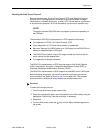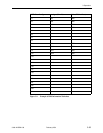
3. Operation
3160-A2-GB21-90 February 2001
3-29
Configuring DS0 Channels
The DSU/CSU provides channel configuration options that allow you to do the
following:
Display the DS0 assignments for the network, DTE Drop/Insert (DSX-1), and
data port interfaces.
Allocate DS0 channels on the DTE Drop/Insert (DSX-1) interface to the
network interface.
Allocate DS0 channels on the network or DTE Drop/Insert (DSX-1) interface to
particular data ports.
Clear (deallocate) all DS0 channels from the network, DTE Drop/Insert
(DSX-1), or data port interface.
Map data from one port to another.
To allocate DS0 channels, begin by defining the logical channel configuration for
the network interface, and then the DTE Drop/Insert (DSX-1) interface, and then
any ports, if desired. See Figure 3-6, Example of Channel Allocation, for an
example of a conceptual diagram of a channel configuration.
Blank configuration worksheets are provided at the back of Appendix C,
Configuration Options
. To complete the configuration worksheets for DS0 channel
allocation:
1. Complete the Network Interface and the DTE Drop/Insert (DSX-1) Interface
tables (unless the DTE Drop/Insert interface is disabled) as shown in the
examples in Figure 3-7, Example of Interface Worksheet for Network Interface,
and Figure 3-8, Example of Interface Worksheet for DTE Drop/Insert Interface.
2. Complete the Robbed Bit Signaling (RBS) information worksheet as shown in
the examples in Figure 3-9, Example of RBS Information Worksheet.
3. Using the worksheets shown in Figure 3-10, Port Channel Configuration
Worksheet (Ports 1 and 2), and Figure 3-11, Port Channel Configuration
Worksheet (Ports 3 and 4), circle the configuration options needed to
implement the logical channel configuration.
Once you have completed the worksheets, enter this information using the
procedures in
Allocating Data Ports
on page 3-38.


















